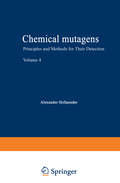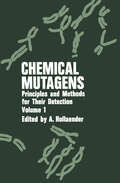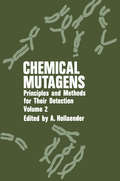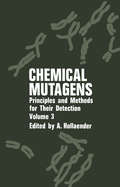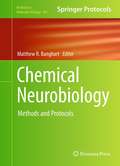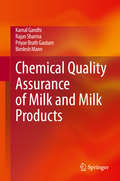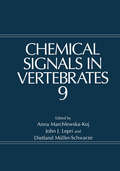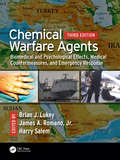- Table View
- List View
Chemical Mutagens: Principles and Methods for Their Detection Volume 8
by Frederick J. De Serr A. HollaenderVolume 8 of Chemical Mutagens covers a wide range of topics in this continuously changing field. This volume includes chapters on the detection of genetic damage in mammalian sperm both at specific loci and over the entire genome. The discussion of in vitro techniques for working with mammalian cells covers not only specific locus assays but also cellular activation systems. Another chapter extensively discusses the need for a revised protocol for the micronucleus assay. Structure activity relationships are investigated in a chapter dealing with hair dye constituents. One of the most comprehensive chapters deals with problems associated with the detection of mutagenic effects in defined human populations. Finally, there is a detailed presentation of a comprehensive study tabulating the genetic bioassay data on some known or suspected human carcinogens. In keeping with our policy of publishing important legislation in the area of chemical mutagens, we have also included the Council of the European Communities Directive of 18 September 1979. Frederick J. de Serres Research Triangle Park, North Carolina vii Contents Chapter 1 Detection of Effects of Mutagens in Human Populations George R. Hoffmann 1. Introduction . . . . . . . . . . . . . . . . . . . . . . . . . . . . . . . . . . . . . . 1 2. Monitoring Progeny for Evidence of Germ-Cell Mutations. . . . . 3 2. 1. The Classical Approach: Phenotypic Monitoring . . . . . . . 3 2. 2. Monitoring for Changes in Gene Products . . . . . . . . . . . 7 3. Detection of Gene Mutations in Somatic Cells. . . . . . . . . . . . . 9 3. 1. Drug-Resistant Lymphocytes . . . . . . . . . . . . . . . . . . . . . . 9 3. 2. Hemoglobin Variants . . . . . . . . . . . . . . . . . . . . . . . . . . . 17 4. Nongenetic Indicators of Mutagen Exposure . . . . . . . . . . . . . 21 4. 1. Alkylation of Proteins . . . . . . . . . . . . . . . . . . . . . . . . . . . 21 4. 2. DNA Damage . . . . . . . . . . . . . . . . . . . . . . . . . . . . . . . . .
Chemical Mutagens: Principles and Methods for Their Detection Volume 4 (pdf)
by Alexander HollaenderChemical Mutagens: Principles and Methods for Their Detection Volume 1
by Alexander HollaenderAs editor I want especially to thank Dr. Ernst Freese for helpful co operation in preparing these volumes, and to express my appreclatlOn to Drs. Kurt Hirschhorn and Marvin Legator, the other members of the editorial board. Alexander Hollaender January 1971 Preface The purpose of these volumes is to encourage the development and ap plication of testing and monitoring procedures to avert significant human exposure to mutagenic agents. The need for protection against exposure to possibly mutagenic chemicals is only now coming to be generally realized. The recently issued Report of the Secretary's Commission on Pesticides and Their Possible Effects on Health (the Mrak Report-U.S. Department of Health, Education and Welfare, December 1969) has made an important start. Its Panel on Mutagenicity recommends that all currently used pesticides be tested for mutagenicity in several recently developed and relatively simple systems. Whether recommendations such as these are actually put into effect will depend on convincing government, industry, and the public that the problem is important, that the proposed tests would be effective, and that they can be conducted at a cost that is not prohibitive. Why is it important to screen environmental agents for mutagenic activity? To those who will read this book, the answer is self-evident. The sine qua non of all that we value and all that we are is our genetic heritage.
Chemical Mutagens: Principles and Methods for Their Detection: Volume 2
by Alexander HollaenderThe best protection against environmental mutagens is to identify them before they ever come into general use. But it is always possible that some substance will escape detection and affect a large number of persons without this being realized until later generations. This article considers ways in which such a genetic emergency might be promptly detected. A mutation-detecting system should be relevant in that it tests for effects that are as closely related as possible to those that are feared. It should be sensitive enough to detect a moderate increase in mutation rate, able to discover the increase promptly before more damage is done, responsive to various kinds of mutational events, and designed in such a way as to maxi mize the probability that the Gause of an increase can be found. Methods based on germinal mutation necessarily involve enormous numbers of persons and tests. On the other hand, with somatic mutations the individual cell becomes the unit of measurement rather than the in dividual person. For this reason, I think that somatic tests are preferable to germinal tests, despite the fact that it is germinal mutations which are feared.
Chemical Mutagens: Principles and Methods for Their Detection Volume 3
by Alexander HollaenderThe ready acceptance and wide demand for copies of the first two volumes of Chemical Mutagens: Principles and Methods Jar Their Detection have demon strated the need for wider dissemination of information on this timely and urgent subject. Therefore, it was imperative that a third volume be prepared to include more detailed discussions on techniques of some of the methods that were presented from a theoretical point of view in the first two volumes, and to update this rapidly expanding field with current findings and the new developments that have taken place in the past three years. Also included is a special chapter by Dr. Charlotte Auerbach giving the historical background of the discovery of chemical mutagenesis. Methods for recognizing mutagenic compounds in vitro are a necessary preliminary step toward arriving at satisfactory solutions for recognizing significant mutation rates in man, which must be done before our test tube methods of detection can be considered reliable. Two chapters in this volume make important contributions to this problem. Due to the increasing activity in efforts to perfect techniques for detecting chemical mutagens and their effects on man, it is planned to continue this series of volumes as necessary to keep abreast of current findings.
Chemical Mutagens: Principles and Methods for Their Detection
by Alexander Hollaender Frederick J. De SerresVolume 9 of Chemical Mutagens consists mainly of chapters discussing the development and validation of short-term assays to detect the mutagenic effects of environmental chemicals. These chapters include an assay with the grasshopper neuroblast, a comparison of mutagenic responses of human lung-derived and skin-derived diploid fibroblasts, a forward-mutation assay in Salmonella, a multigene sporulation test in Bacillus subtilis, a specific locus assay in mouse lymphoma cells, a study of the induction of bacteriophage lambda, and the granuloma pouch assay. In addition, there are two chapters on the identification of mutagens in cooked food and in human feces. Frederick 1. de Serres Research Triangle Park, North Carolina vii Contents Chapter 1 The Grasshopper Neuroblast Short-Term Assay for Evaluating the Effects of Environmental Chemicals on Chromosomes and Cell Kinetics 1 Mary Esther Gaulden, Jan C. Liang, and Martha J. Ferguson 1. Introduction. . . . . . . . . . . . . . . . . . . . . . . . . . . . . . . . . . . . 1 2. Embryo Supply. . . . . . . . . . . . . . . . . . . . . . . . . . . . . . . . . . 4 2. 1. Species. . . . . . . . . . . . . . . . . . . . . . . . . . . . . . . . . . . . 4 2. 2. Origin of Colonies . . . . . . . . . . . . . . . . . . . . . . . . . . . 4 2. 3. Life Cycle . . . . . . . . . . . . . . . . . . . . . . . . . . . . . . . . . 5 2. 4. Colony Maintenance . . . . . . . . . . . . . . . . . . . . . . . . . 6 2. 5. Pathology . . . . . . . . . . . . . . . . . . . . . . . . . . . . . . . . . 13 2. 6. Allergy to Grasshoppers . . . . . . . . . . . . . . . . . . . . . . 14 3. Grasshopper Egg, Embryo, and Cells . . . . . . . . . . . . . . . . . 14 3. 1. The Egg Shell and Membranes . . . . . . . . . . . . . . . . . 14 3. 2. Embryonic Development . . . . . . . . . . . . . . . . . . . . . . 17 3. 3. Cells . . . . . . . . . . . . . . . . . . . . . . . . . . . . . . . . . . . . . 20 4. Methods . . . . . . . . . . . . . . . . . . . . . . . . . . . . . . . . . . . . . . . 26 4. 1. Exposure . . . . . . . . . . . . . . . . . . . . . . . . . . . . . . . . . . 26 4. 2. Preparation of Embryos for Cell Analysis . . . . . . . . . 34 4. 3. Analysis of Mutagen Effects. . . . . . . . . . . . . . . . . 40 . . . 5. Response of the Grasshopper Neuroblast to Mutagens . . . . 50 5. 1. Reproducibility of Data . . . . . . . . . . . . . . . . . . . . . . . 50 5. 2. Radiation. . . . . . . . . . . . . . . . . . . . . . . . . . . . . . . . . . 51 5. 3. Chemical Mutagens . . . . . . . . . . . . . . . . . . . . . . . . . .
Chemical Mutagens: Principles and Methods for Their Detection
by Frederick J. Serres Alexander HollaenderNew developments in the study of environmental mutagens continue to evolve in this rapidly emerging field. In Volume 7 of Chemical Mutagens, we have focused on various new techniques for the detection of genetic damage in somatic cells and germ cells of mammals and the use of lower eukaryotic microorganisms to detect aneuploidy as well as other types of genetic damage. Attention has also been given to the role of in vitro metabolic activation as a mechanism for modifying the genetic effects of different environmental chemicals. In a chapter on compar ative mutagenesis, reaction kinetics and their relationship to the mu tagenic action of monofunctional alkylating agents in higher eukaryotic organisms are examined. In another chapter, the pharmacology and toxicology of nitrites and nitrates, which are in widespread distribution in the environment, are discussed in detail. The books in this series have provided a mechanism for the publication of many important new developments in the study of the genetic effects of environmental chemicals. This series was launched by Dr. Alexander Hollaender who, beginning in 1971, edited Volumes 1-4 and then coedited Volumes 5-7. The success of his lO-year effort with these volumes is another testimony to Dr. Hollaender's many contri butions to the field of environmental mutagenesis. As Dr.
Chemical Neurobiology: Methods and Protocols (Methods in Molecular Biology #995)
by Matthew R. BanghartMany advances in modern neuroscience are enabled by the availability of chemical tools that allow sensitive, precise, and quantitative measurements of, and control over, biological processes. These powerful reagents are widely used for investigating the nervous system at levels of detail ranging from ion channel structure to neural network dynamics. Recent advances in photochemistry, microscopy, and protein engineering have triggered a surge in the development and application of these interdisciplinary techniques. Chemical Neurobiology: Methods and Protocols assists with the design, characterization and validation of new chemical tools for neurobiology by providing detailed protocols of procedures and assays deemed essential for the successful development and implementation of such tools. Divided into three sections, topics cover chemical probes of membrane protein structure and function, photochemical control of protein and cellular function, and chemical probes for imaging in the nervous system. Written in the successful Methods in Molecular Biology™ series format, chapters include introductions to their respective topics, lists of the necessary materials and reagents, step-by-step, readily reproducible protocols, and notes on troubleshooting and avoiding known pitfalls. Authoritative and easily accessible, Chemical Neurobiology: Methods and Protocols serves scientists at many levels, including students aiming to expand their perspective, laboratory researchers seeking technical guidance, and established investigators looking for creative solutions to their research problems in molecular, cellular and systems neuroscience.
Chemical Ocular Burns: New Understanding and Treatments
by Norbert Schrage François Burgher Jöel Blomet Lucien Bodson Max Gerard Alan Hall Patrice Josset Laurence Mathieu Harold MerleMore than 25,000 chemical products have the potential to cause ocular burns. Because such burns can result in loss of sight or the need for corneal transplantation, they must be taken very seriously. This book is the first to be devoted entirely to chemical ocular burns. All aspects of the subject are covered, including history, epidemiology, chemical agents and reactions, histology, pathophysiology, clinical signs, medical and surgical treatments, and emergency care. Particular attention is paid to the mechanisms involved in ocular burns and to the links between the chemical reactivity of corrosive agents and the clinical manifestations. Current principles of decontamination are fully explained and the latest treatment techniques are discussed in detail. This book stands at the interface of the chemical and medical sciences. It will be of great practical value to ophthalmologists and doctors in emergency medical and burns units, and will acquaint chemists with the clinical consequences of corrosivity.
Chemical Peels in Clinical Practice: A Practical Guide to Superficial, Medium, and Deep Peels (Series in Cosmetic and Laser Therapy)
by Xavier G GoodarzianXavier Goodarzian, MD(Hons), MRCGP, PGDiplClinDerm, PGCertCosMed, MBCAM, is the medical director of the Dr Xavier Clinic in Southampton and London, UK, where he has performed chemical peels since 2006. A medical graduate of the University of Louvain (Leuven) in Belgium, he obtained member status of the Royal College of General Practitioners and has postgraduate degrees in Clinical Dermatology (Queen Mary University of London) and Cosmetic Medicine (University of Leicester) in the UK. A full member of the British College of Aesthetic Medicine, he is an officially recognised trainer and Key Opinion Leader for SkinTech in the UK, holds training and mentoring sessions internationally, and has spoken at many live events in conferences in various countries. He is passionate about skincare, skin health, and chemical peels. This book has been written with the aim of making a practitioner’s peeling experience easier and more practical. It contains sample patient forms, over 250 illustrations, and a wealth of tips for patient guidance and safe clinical practice.
Chemical Peels in Clinical Practice: A Practical Guide to Superficial, Medium, and Deep Peels (Series in Cosmetic and Laser Therapy)
by Xavier G GoodarzianXavier Goodarzian, MD(Hons), MRCGP, PGDiplClinDerm, PGCertCosMed, MBCAM, is the medical director of the Dr Xavier Clinic in Southampton and London, UK, where he has performed chemical peels since 2006. A medical graduate of the University of Louvain (Leuven) in Belgium, he obtained member status of the Royal College of General Practitioners and has postgraduate degrees in Clinical Dermatology (Queen Mary University of London) and Cosmetic Medicine (University of Leicester) in the UK. A full member of the British College of Aesthetic Medicine, he is an officially recognised trainer and Key Opinion Leader for SkinTech in the UK, holds training and mentoring sessions internationally, and has spoken at many live events in conferences in various countries. He is passionate about skincare, skin health, and chemical peels. This book has been written with the aim of making a practitioner’s peeling experience easier and more practical. It contains sample patient forms, over 250 illustrations, and a wealth of tips for patient guidance and safe clinical practice.
Chemical Probes in Biology: Science at the Interface of Chemistry, Biology and Medicine (NATO Science Series II: Mathematics, Physics and Chemistry #129)
by Manfred P. SchneiderThis NATO Advanced Study Institute (co-sponsored by FEBS and INTAS) under the title "Chemical Probes in Biology" was designed to summarize and disseminate recent expert knowledge regarding a deeper understanding ofbiological phenomena on a molecular level. Such scientific activities -frequently termed Bio-organic Chemistry or Chemical Biology are constituting a highly interdisciplinary branch of chemistry beyond the traditional ways in which chemists and biologists have been working in the past. Thus, on this occasion we were bringing together senior experts from the disciplines of Chemistry and Biology in order to amalgamate their diverse yet basically common interests in this area. Ultimate goal was - next to an exchange of information between the two scientific cultures - the communication ofexciting possibilities in interdisciplinary research to the young scientists present. The meeting was held in the Anargyros and Korgialenios School on the Island ofSpeteses, Greece from 18-30 August 2002. The ASI was attended by a total of 91 scholars from 23 different countries. A group of 27 speakers presented a series of 34 highly stimulating, informative and educational lectures covering a broad range of topics relevant to the general theme ofthis meeting: Science at the InteifaceofChemistry, Biology and Medicine. The lectures were complemented by a total of 89 posters presented by the young scholars and a series of short lectures derived thereof This was clearly one ofthe highlites of the meeting creating a lively atmosphere of interaction and intellectual creativity - typical phenomena for the whole meeting.
Chemical Probes in Biology: Science at the Interface of Chemistry, Biology and Medicine
by Philip J. SnodgrassOrnithine Transcarbamylase: Basic Science and Clinical Considerations, written by a leading expert on OTC, for the first time assembles and analyzes more than 40 years of basic science and clinical research. It will be the definitive resource on the topic for pediatricians, geneticists, and internists who care for patients with OTC deficiency, as well as for basic scientists and genetic researchers who study the urea cycle in mammals and the arginine biosynthetic pathway in bacteria and fungi.
Chemical Products and Processes: Foundations of Environmentally Oriented Design
by Martin Scheringer Konrad Hungerbühler Justin M. Boucher Cecilia Pereira Thomas RoissThis textbook provides both students and professionals alike with a transdisciplinary and comprehensive foundation to design responsible chemical products and processes that protect human health and the environment. It serves as a compact guide that brings together knowledge and tools from across multiple disciplines. Readers are introduced to a set of core topics with focus placed on basic technical methods and tools (including life cycle assessment, product and process risk assessment, and thermal safety concepts) as well as on important normative topics (including philosophical, societal, and business perspectives in addition to current environmental and safety legislation). Developed in collaboration with industry partners, this textbook also provides a workable, illustrative case study that guides readers through applying the fundamentals learned to the production and application of a real-world chemical product. Building upon the success of its first German edition published in 1998, this latest edition has been significantly updated and expanded to reflect developments over the past two decades. Its publication comes at a key time when the volume and pace of global chemical production is dramatically increasing, and the rise of social media and informed citizen scientists make the dialogue with stakeholders even more important and demanding. This textbook is a valuable resource for both the current and next generation of scientists and engineers that will be tasked with addressing the many challenges and opportunities that are appearing as a result. Covering a wide range of interconnected topics at a fundamental level applicable across scientific study programs and professions, this textbook fills a need not met by many of the other more specialized textbooks currently available.
Chemical Quality Assurance of Milk and Milk Products
by Kamal Gandhi Rajan Sharma Priyae Brath Gautam Bimlesh MannThis book discusses quality-related aspects of milk and milk products, covering the various analytical procedures for testing the quality and composition. It also describes the adulteration of milk and milk products and the common as well as advanced techniques used to detect such adulteration. Further, the book examines food laws, guidelines and regulations laid down by FSSAI, CODEX, ISO, IDF and USFDA, and addresses the functioning of a number of international and national organizations, including the WTO, Codex Alimentarius Commission, and BIS. Familiarizing readers with the concepts of QC, TQM, PDCA cycle and related concepts of quality assurance, the book also provides information on other topics that indirectly contribute to the quality of milk and milk products, like the calibration of milk testing equipment, quality of water used in milk processing and the standardization of various chemicals used for testing. This book is a valuable resource for researchers and industry professionals dealing with dairy products.
Chemical Reagents for Protein Modification
by Roger L. LundbladThe use of the chemical modification of proteins has evolved over the past 80 years, benefiting from advances in analytical, physical, and organic chemistry. Over the past 30 years, the use of chemical reagents to modify proteins has been crucial in determining the function and structure of purified proteins. This groundbreaking work is part of the
Chemical Relaxation in Molecular Biology (Molecular Biology, Biochemistry and Biophysics Molekularbiologie, Biochemie und Biophysik #24)
by M. Ehrenberg E. Grell D. M. Hague G. Ilgenfritz T. M. Jovin D. Lancet D. Magde I. Oberbäumer I. Pecht F. M. Pohl D. Pörschke R. Rigler Peter Schuster G. Striker D. Thusius K. Tortschanoff W. Wintermeyer P. WolschannThe development of an area of scientific research is a dynamic process with its own kinetic equations and its own physical mech anism. The study of fast chemical interactions and transformations is such an area, and while it is tempting to draw analogies or to speculate about the simplest model system, the lack of ade quately averaged observables is an annoying obstacle to such an undertaking. Sciences suffering from such conditions usually avoid quantitative models, be they primitive or complex. Instead, they prove their point by "case histories". Chemical relaxation kinetics started as an offspring of research in acoustics. In some aqueous ionic solutions anomalous acoustic absorption had been observed. A systematic study traced the cause of this absorption, showing that the covered frequency range and the intensity of the absorption were related in a predictable manner to the rate at which ions can interact and form structures differing in volume from the non interacting species. The step from this experimental observation and its correct, non trivial explanation to the discovery that all fast chemical pro cesses must reveal themselves quantitatively in the relaxation rate of a perturbed equilibrium state, and that perturbation para meters other than sound waves can be used for its exploitation, was made by MANFRED EIGEN in 1954. The foresightedness of K.F.
Chemical Safety Sheets: Working Safely with Hazardous Chemicals (Chemical Safety Sheets)
by Chemical Industry Association, VNCI, the NetherlandsThe Chemical Scythe: Lessons of 2,4,5-T and Dioxin (Disaster Research in Practice)
by Alastair HayThe Chemical Scythe is the first book in a projected series to be published by Plenum Press in association with the International Disaster Institute. The aim of the series, Disaster Research in Practice, is to provide scientific and readable accounts on the most urgent areas of disaster research. It is fitting, therefore, that Dr. Hay's investigation into the nature and effects of dioxins heralds the new series. The problem of chemical hazards is one that we will have to learn to live with in future decades. Dr. Hay's book is an authoritative account of the chemistry and proven and potential effects of dioxins, and of the impli cations for safety planning. He concludes with a cautious, yet optimistic note-that indeed we can learn to live with such hazards, providing that we are prepared to understand and plan for the unexpected. The accident at Seveso in 1976 alerted the world to an imperfectly un derstood but immensely alarming environmental hazard. Public debate and argument as to the implications of dioxins and, indeed, the use of herbicides as aggressive weapons in Vietnam, rage on. And yet it is only through the painstaking research exemplified in this book that it will eventually be pos sible to promote the vital accountability on the part of industrialists and governments.
Chemical Sensors: An Introduction for Scientists and Engineers
by Peter GründlerResearch in the area of chemical and biochemical sensors and the development of respective applications is still growing rapidly. This book aims at instructing researcher and practitioners in both disciplines in a strictly systematic, interdisciplinary and practice-oriented way about the basic technology of chemical and biochemical sensors. This concise volume bridges the gap between the different "ways of thinking" in chemistry, physics and engineering. It provides a firm grounding for engineers, industrial and academic researcher in the field, for practitioners and novices as well as for advanced students.
Chemical Signals in Vertebrates 9
by Anna Marchlewska-Koj John J. Lepri Dietland Müller-SchwarzeIt is generally accepted that the recent progress in molecular and cellular biology would not have been possible without an understanding of the mechanisms and signaling pathways of communication inside the cell and between various cells of the animal organism. In fact a similar progress occurred in the field of chemical communication between individual organisms of vertebrate species, and this volume is aimed at presenting the current state of the art on this subject. The reader can find here both original results obtained in the laboratory or field studies and comprehensive reviews summarizing many years of research. The presentations of over 60 scientists have been grouped according to their approach into nine parts covering such fields as ecological and evolutionary aspects of chemical communication, structure and neuronal mechanisms of chemosensory systems, chemical structure of pheromones and binding proteins, kin, individual and sexual recognition, predator-prey relationships, purpose and consequences of marking behavior, scent signals and reproductive processes. Expanding on former volumes of this series, entirely new chapters have been added on prenatal chemical communication describing specific effects of the intrauterine environment. In many cases a truly multidisciplinary approach was required, such as with the population analysis of polymorphic variants of the mouse's major urinary proteins that function in carrying pheromones.
Chemical Skin Injury: Mechanisms, Prevention, Decontamination, Treatment
by Howard I. Maibach Alan H. HallThis book provides an up-to-date, compact but comprehensive review of chemical skin injuries, differentiating them from thermal skin burns. After an introductory chapter on the history of chemical skin injuries and the scope of the problem, the anatomy, histology, physiology, and immunology of normal skin are described. Mechanisms involved in chemical penetration of normal skin are explained, and the effects of damaged skin on chemical penetration are analyzed. The remainder of the book discusses a variety of clinically relevant aspects, such as the different forms of chemical skin injury, including injuries that arise during skin peeling or due to hair products; preventive measures; emergency treatment; rinsing therapy; medical and surgical treatment; and the importance of providing relevant information to workers. The role of predictive toxicology is also considered.
Chemical Warfare Agents: Chemistry, Pharmacology, Toxicology, and Therapeutics, Second Edition
by Brian J. Lukey James A. Romano Harry Salem James A. Romano Jr.The first edition of this book, Chemical Warfare Agents: Toxicity at Low Levels, was published just prior to the terrorist attacks of September 11th, 2001. Reflecting a greater sense of urgency within the field of chemical defense since this event, research related to chemical warfare agents (CWAs) continues to expand at a remarkable pace. <
Chemical Warfare Agents: Biomedical and Psychological Effects, Medical Countermeasures, and Emergency Response
by Brian J. Lukey James A. Romano Jr. Harry SalemThe first edition of this book, Chemical Warfare Agents: Toxicity at Low Levels, was published just prior to the terrorist attacks of September 11, 2001. The second edition titled, Chemical Warfare Agents: Pharmacology, Toxicology, and Therapeutics, included new epidemiological and clinical studies of exposed or potentially exposed populations; new treatment concepts and products; improved organization of the national response apparatus addressing the potential for CWA terrorism; and improved diagnostic tests that enable rapid diagnosis and treatment. Since the second edition, the chemical warfare agent community has worked hard to advance research for protection and treatment and develop/improve response approaches for individuals and definitive care. Consequently, in addition to updating previous chapters, Chemical Warfare Agents: Biomedical and Psychological Effects, Medical Countermeasures, and Emergency Response, Third Edition features several new chapters that address the Syrian War, chemical destruction, the Organisation for the Prohibition of Chemical Weapons, biomarkers for chemical warfare agent exposure, field sensors, aircraft decontamination, lung/human on a chip, chemical warfare response decision making, and other research advancements. Features: Describes the newest medical interventions, and the latest technologies deployed in the field, as well as developments in the international response to CW usage highlighting recent events in the Middle East Discusses the latest in organizational/interagency partitioning in terms of responsibilities for emergency response, not just in the United States but at the international level—whether prevention, mitigation, medical care, reclamation, or medico-legal aspects of such response Contains the most current research from bench-level experts The third edition contains the most up-to-date and comprehensive coverage of the question of chemical warfare agent employment on the battlefield or in terrorism. Edited by workers that have been in the field for 35+ years, it remains faithful to the scientific "constants," while evaluating and crediting the advances by the industry that have made us safer.
Chemical Warfare Agents: Biomedical and Psychological Effects, Medical Countermeasures, and Emergency Response
by Brian J. Lukey James A. Romano Jr. Harry SalemThe first edition of this book, Chemical Warfare Agents: Toxicity at Low Levels, was published just prior to the terrorist attacks of September 11, 2001. The second edition titled, Chemical Warfare Agents: Pharmacology, Toxicology, and Therapeutics, included new epidemiological and clinical studies of exposed or potentially exposed populations; new treatment concepts and products; improved organization of the national response apparatus addressing the potential for CWA terrorism; and improved diagnostic tests that enable rapid diagnosis and treatment. Since the second edition, the chemical warfare agent community has worked hard to advance research for protection and treatment and develop/improve response approaches for individuals and definitive care. Consequently, in addition to updating previous chapters, Chemical Warfare Agents: Biomedical and Psychological Effects, Medical Countermeasures, and Emergency Response, Third Edition features several new chapters that address the Syrian War, chemical destruction, the Organisation for the Prohibition of Chemical Weapons, biomarkers for chemical warfare agent exposure, field sensors, aircraft decontamination, lung/human on a chip, chemical warfare response decision making, and other research advancements. Features: Describes the newest medical interventions, and the latest technologies deployed in the field, as well as developments in the international response to CW usage highlighting recent events in the Middle East Discusses the latest in organizational/interagency partitioning in terms of responsibilities for emergency response, not just in the United States but at the international level—whether prevention, mitigation, medical care, reclamation, or medico-legal aspects of such response Contains the most current research from bench-level experts The third edition contains the most up-to-date and comprehensive coverage of the question of chemical warfare agent employment on the battlefield or in terrorism. Edited by workers that have been in the field for 35+ years, it remains faithful to the scientific "constants," while evaluating and crediting the advances by the industry that have made us safer.

